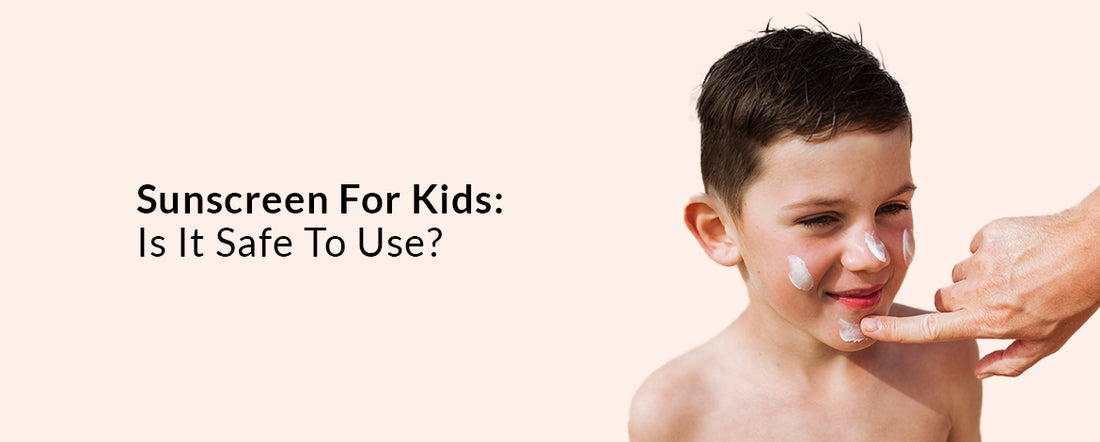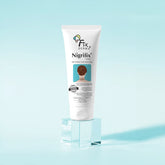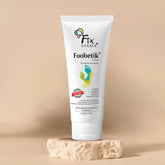Sunscreen For Kids: Is It Safe To Use?

Long-term exposure to strong sun rays undoubtedly affects our skin. Even on a cloudy or rainy day, the effects of the sun’s rays are not deemed. Various skin concerns such as sunburns, damages caused by UVA and UVB rays, and even skin cancer can appear due to sun exposure for longer durations. Therefore, we all need to sun-protect our skin proper sun protection is needed by all before stepping out to protect your skin from long-term sun damage.
The application of sunscreen is a must for everyone whether an adult or a child to protect the skin from harmful UV rays. However, every mother has the question of whether the application of sunscreen is safe for their child or not.
The answer to this question is yes. It has been dermatologically proven that sunscreens can be applied to children as well. But, before choosing a sunscreen for your kids, it's important to know what ingredients suit their skin and more importantly, what is the safest option available.
Today’s blog is all about exploring the safety and efficiency of child-friendly sunscreen and which ingredients should parents look for while choosing sun protection for their little ones.
The Importance of Sunscreen for Kids
Children's skin is more sensitive and prone to damage from UV radiation compared to adult skin. A child's skin is thinner, and the protective pigment melanin is not fully developed, making them more susceptible to sunburns and long-term skin damage.
According to dermatologists, just a few serious sunburns during childhood can increase the risk of skin cancer later in life. Therefore, using sunscreen is not just safe but essential for kids.
Understanding Sunscreen Ingredients for Kids
Making the right choice of sunscreens for the kids is equally important. The choice of ingredients should be made diligently as the delicate skin of kids is also prone to side effects of the harsh active ingredients. Labeled child-friendly sunscreens should be used to protect kids from harmful UV rays as these are specially formulated for their sensitive and soft skin. Make sure that you check for ‘child-friendly’ labels to ensure the quality and effectiveness of the product and avoid products that contain Benzophenones (oxybenzone, dioxybenzone, sulisobenzone), Cinoaxate and Menthyl anthranilate, also known as meradimate.
Mineral Sunscreens
Mineral sunscreens (also known as physical sunscreens) use active mineral ingredients like zinc oxide and titanium dioxide to physically block UV radiation. These sunscreens are less likely to cause skin irritation and are generally considered safe for children, even those with sensitive skin or eczema.
Hypoallergenic Sunscreens
Hypoallergenic sunscreens for kids are formulated carefully with ingredients that reduce the risk of allergic reactions. Children’s skin dries out more easily than adults and hence, itches, rashes, and peeling are more likely to occur. Sweating, swimming, dry air, and freezing temperatures might exacerbate these symptoms. So, before engaging in such activities, ensure sure the appropriate safety measures are taken. For children with eczema and other similar skin conditions, ensure that a hypoallergenic sunscreen for sensitive skin is chosen. Patch testing should always be done before giving children any new products.
Fixderma Product Recommendations
Fixderma offers two efficient hypoallergenic sunscreens that offer strong protection from harmful UV rays.
- Fixderma Shadow Kids SPF 30+ Lotion: A broad-spectrum sunscreen that offers both UV and UVB protection and excellent moisturization. Prepared with the blend of the safest sun protectors like Sun Cate- DE, Niacinamide, Zinc oxide, and Vitamin E this lotion is ultra-light and oil-free.
- Fixderma Shadow Roll On Sunscreen For Kids SPF 50: It offers straight 12-hour protection from the sun. This non-teary formula is a transparent formulation that is paraben-free and cruelty-free. Crafted with ingredients like golden seaweed, avobenzone, and Vitamin E, this sunscreen can be used all over the body without causing a white cast or greasiness.
Pediatric Sunscreen Safety: Expert Tips for Worry-Free Application
Pediatric sunscreen safety is a paramount concern for parents. The good news is that sunscreens designed for children are generally safe when used as directed. Experts suggest that you should not apply sunscreen on infants younger than 6 months old. This is the reason why you should keep them out of direct sunlight, especially between 10.00 am to 4.00 pm, as during this time the risk of sunburns and sunrashes is highest.
On the other hand, application of sunscreen is safe for babies older than 6 months. To ensure great sun protection for kids, look for ingredients like titanium dioxide or zinc oxide on the sunscreen labels.
Be careful while applying sunscreen on the face as it has to be avoided around the eyes. If sunscreen comes in contact with the eyes, make sure that you immediately wipe the area with a damp cloth to avoid any irritation.
Comprehensive Sun Protection for Kids
Kids' sun protection should be a comprehensive strategy that includes more than just sunscreen. Sun-protecting kids’ skin should be strategized and the following points should be kept in mind to avoid sun-induced damage to the kids’ delicate skin:
- The UVA and UVB rays are the strongest from 10.00 am to 2.00 pm. Therefore, it would be best to keep protected from the sun and undertake indoor activities at this time.
- Choose a broad-spectrum sunscreen with a good SPF, minimum of 30 which blocks about 97% of UV and UVB rays.
- Apply sunscreen on the face and body, for about 15 to 30 minutes before going out in the sun.
- Water-resistant sunscreens are essential for maintaining protection during swimming and sweating. Look for products labeled "water-resistant" or "very water-resistant" and reapply every 40 to 80 minutes, depending on the product's specifications.. These will last for a minimum of 80 minutes on the skin and are crafted to stay on even after contact with water.
- Sunscreen should be reapplied every two hours, or more often if your child is swimming or sweating. Even water-resistant sunscreens need to be reapplied regularly to maintain effectiveness.
- Opt for sun-protective, full-sleeve clothing for your children. Compared to regular ones, these tightly woven, light-colored clothes offer superior protection by blocking the sun's damaging rays.
- Ensure your child wears sunglasses and other accessories like a wide-brim hat while going out in the sun.
Since sunscreen is not an option for newborns under six months old, safety measures should be implemented. These are a handful that need to be considered.
- Keep your baby in the shade while being outdoors to avoid direct sun exposure.
- Although sunscreens are not suggested on infants before 6 months, make sure that you consult with pediatrics in case of any concern.
- Ensure that the baby is dressed in a manner that protects the baby’s skin from direct sunlight.
- Always keep an eye out for sunburn and dehydration in babies, especially in summer. Fussiness, redness, and excessive crying are a few warning signs.
- Apply a cold compress in case of sunburn and consult a doctor right away.
Sunscreen Allergies in Children: Prevention and Management
While rare, some children may develop allergic reactions to sunscreen. Symptoms can include redness, itching, swelling, or a rash. If your child shows signs of an allergic reaction, discontinue use immediately and consult a pediatrician. Some of the sun-induced allergies prone to children include:
- Allergic Contact Dermatitis: Itching, redness, rash, swelling, and blisters are the common causes of these. The allergens include benzophenone-4, octinoxate, and oxybenzone in sunscreens. These can be identified easily through a patch test as symptoms show up within a few minutes of application. Chemical sunscreens like oxybenzone, octinoxate, and octocrylene can cause allergic contact dermatitis when they absorb UV light and convert it into heat to help block rays.
- Irritant Contact Dermatitis is caused by alcohol, fragrances, and dyes present in the sunscreens. Redness, stinging, and burning sensations are common indications. Fragranced sunscreens are more likely to irritate sensitive and gentle skin.
- Photoallergic Contact Dermatitis: Caused by the absorption of UV rays, this type of Dermatitis occurs as a rash. The retinoids present in certain sunscreens can also cause this reaction.
- Preservatives: Opt for a paraben-free sunscreen for your kid to sun-protect the delicate skin of the kids. Preservatives like formaldehyde releasers and isothiazolinones are added to products to prevent the growth of microbes which can cause an allergy in children.
Note: Consult a pediatric or a medical practitioner in case of allergy symptoms.
Conclusion: Ensuring Safe Sun Protection for Kids
These days, the majority of parenthood is keeping an eye on your child's health, particularly concerning sunburns and responses to sunscreen brought on by allergic reactions and sensitive skin. Determining the appropriate course of action for protecting against the sun is crucial. Children can be shielded from UV harm by wearing sunscreen. While playing in the pool, choose a water-resistant, kids' sunscreen that is hypoallergenic and has a minimum of 30 SPF. In case of allergy or irritation, consider consulting a physician.
In conclusion, effective sun protection for children involves several key practices that include reapplication of sunscreen every two hours or after sweating or swimming, as water-resistant sunscreens are not waterproof. For kids, sunscreen lotions are more reliable. Clothing labeled "UPF 30 (the amount of UV radiation that can penetrate fabric and reach your skin)" or higher should be used for added protection. Combining these methods with the right sunscreen will provide the best defense against harmful UV rays.









